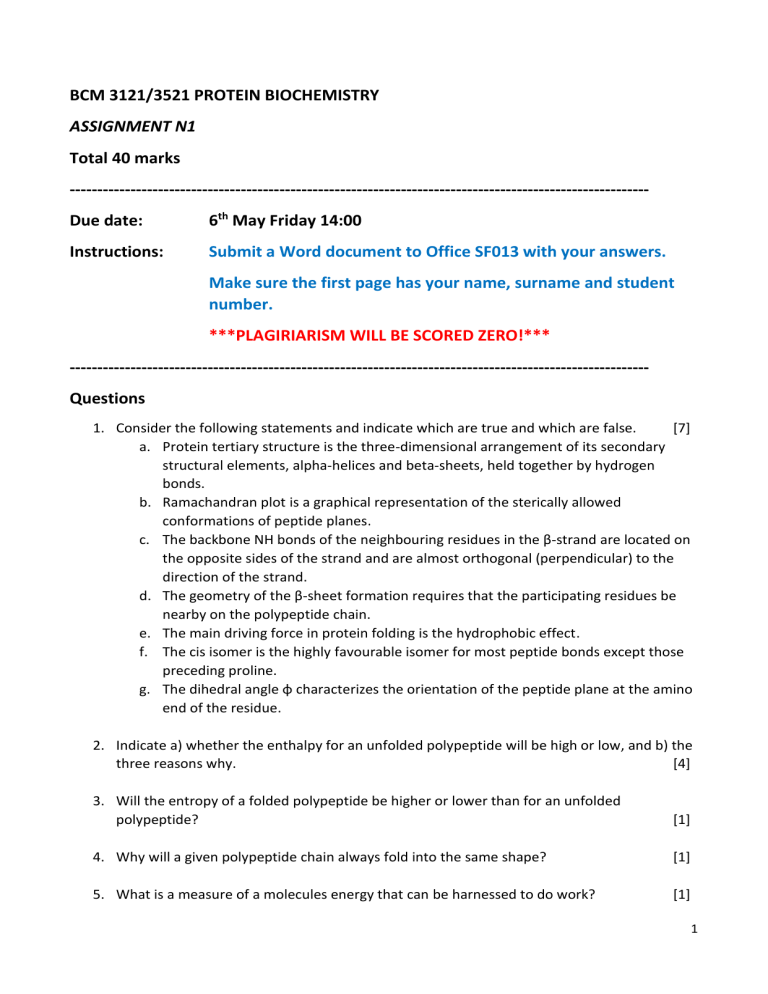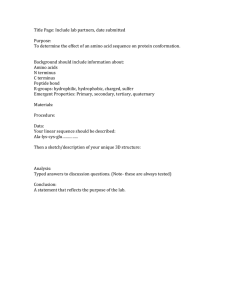
BCM 3121/3521 PROTEIN BIOCHEMISTRY ASSIGNMENT N1 Total 40 marks --------------------------------------------------------------------------------------------------------Due date: 6th May Friday 14:00 Instructions: Submit a Word document to Office SF013 with your answers. Make sure the first page has your name, surname and student number. ***PLAGIRIARISM WILL BE SCORED ZERO!*** --------------------------------------------------------------------------------------------------------Questions 1. Consider the following statements and indicate which are true and which are false. [7] a. Protein tertiary structure is the three-dimensional arrangement of its secondary structural elements, alpha-helices and beta-sheets, held together by hydrogen bonds. b. Ramachandran plot is a graphical representation of the sterically allowed conformations of peptide planes. c. The backbone NH bonds of the neighbouring residues in the β-strand are located on the opposite sides of the strand and are almost orthogonal (perpendicular) to the direction of the strand. d. The geometry of the β-sheet formation requires that the participating residues be nearby on the polypeptide chain. e. The main driving force in protein folding is the hydrophobic effect. f. The cis isomer is the highly favourable isomer for most peptide bonds except those preceding proline. g. The dihedral angle φ characterizes the orientation of the peptide plane at the amino end of the residue. 2. Indicate a) whether the enthalpy for an unfolded polypeptide will be high or low, and b) the three reasons why. [4] 3. Will the entropy of a folded polypeptide be higher or lower than for an unfolded polypeptide? [1] 4. Why will a given polypeptide chain always fold into the same shape? [1] 5. What is a measure of a molecules energy that can be harnessed to do work? [1] 1 6. Describe the difference between a a) polar and b) nonpolar molecule. [4] 7. A particular protein is composed of a 15-residue alpha-helix with the following sequence: WEANIKQRLSTEYKQ a. Consider the peptide and indicate how many full turns this peptide contains. [3] b. Consider the peptide and indicate what the length of the helix is, in the direction of the helix axis and give the answer in Angströms. [3] 8. Consider the polypeptide sequence below and list the amino acids that will probably be packed against the rest of the protein and will thus participate in the formation of the hydrophobic core. [4] PENQWKQELDTRYRNALQ 9. Consider the peptide shown below, and indicate what interactions (in addition to hydrogen bonding) would stabilize the helix. Name the interactions and use lines to connect the amino acids that are involved in these interactions. [4] PENQWKQELDTRYRNALQ 10. What is the comparison between parallel and antiparallel beta sheets? [4] 11. What is the difference between regular and irregular secondary structure? [4] --------------------------------------------------END OF ASSIGNMENT-------------------------------------------------- 2




